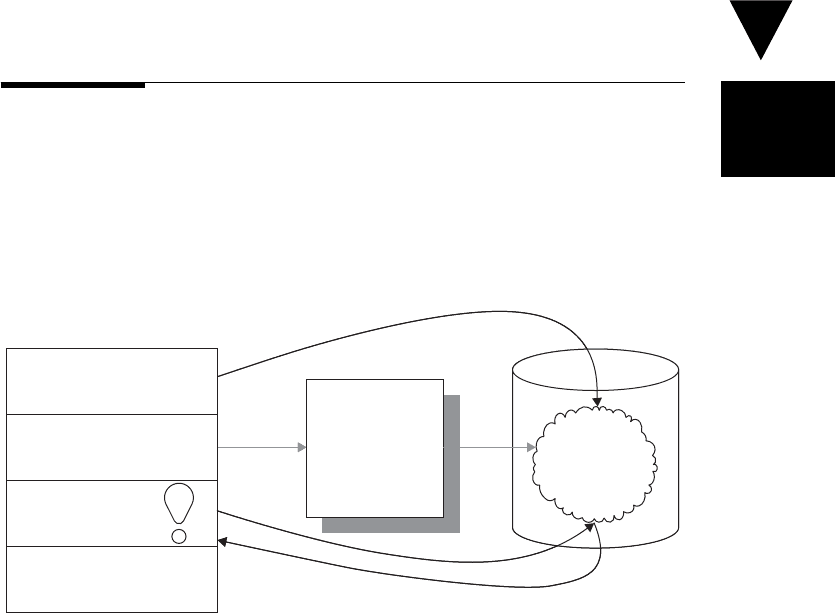Meszaros G. xUnit Test Patterns Refactoring Test Code
Подождите немного. Документ загружается.


When to Use It
Regardless of why we use them, Shared Fixtures come with some baggage that
we should understand before we head down this path. The major issue with a
Shared Fixture is that it can lead to interactions between tests, possibly resulting
in Erratic Tests (page 228) if some tests depend on the outcomes of other tests.
Another potential problem is that a fi xture designed to serve many tests is bound
to be much more complicated than the Minimal Fixture (page 302) needed for a
single test. This greater complexity will typically take more effort to design and
can lead to a Fragile Fixture (see Fragile Test on page 239) later on down the
road when we need to modify the fi xture.
A Shared Fixture will often result in an Obscure Test (page 186) because
the fi xture is not constructed inside the test. This potential disadvantage can be
mitigated by using Finder Methods (see Test Utility Method on page 599) with
Intent-Revealing Names [SBPP] to access the relevant parts of the fi xture.
There are some valid reasons for using a Shared Fixture and some misguided
ones. Many of the variations have been devised primarily to mitigate the negative
consequences of using a Shared Fixture. So, what are good reasons for using a
Shared Fixture?
Variation: Slow Tests
We can use a Shared Fixture when we cannot afford to build a new Fresh Fixture
for each test. Typically, this scenario will occur when it takes too much processing
to build a new fi xture for each test, which often leads to Slow Tests (page 253).
It most commonly occurs when we are testing with real test databases due to
the high cost of creating each of the records. This growth in overhead tends to
be exacerbated when we use the API of the SUT to create the reference data,
because the SUT often does a lot of input validation, which may involve reading
some of the just-written records.
A better solution is to make the tests run faster by not interacting with the
database at all. For a more complete list of options, see the solutions to Slow
Tests and the sidebar “Faster Tests Without Shared Fixtures” (page 319).
Shared
Fixture
318
Chapter 18 Test Strategy Patterns

Faster Tests Without Shared Fixtures
The fi rst reaction to Slow Tests (page 253) is often to switch to a Shared
Fixture (page 317) approach. Several other solutions are available, how-
ever. This sidebar describes some experiences on several projects.
Fake Database
On one of our early XP projects, we wrote a lot of tests that accessed
the database. At fi rst we used a Shared Fixture. When we encountered
Interacting Tests (see Erratic Test on page 228) and later Test Run Wars
(see Erratic Test), however, we changed to a Fresh Fixture (page 311)
approach. Because these tests needed a fair bit of reference data, they
were taking a long time to run. On average, for every read or write the
SUT did to or from the database, each test did several more. It was tak-
ing 15 minutes to run the full test suite of several hundred tests, which
greatly impeded our ability to integrate our work quickly and often.
At the time, we were using a data access layer to keep the SQL out of
our code. We soon discovered that it allowed us to replace the real data-
base with a functionally equivalent Fake Database (see Fake Object on
page 551). We started out by using simple
HashTables to store the objects
against a key. This approach allowed us to run many of our simpler tests
“in memory” rather than against the database. And that bought us a sig-
nifi cant drop in test execution time.
Our persistence framework supported an object query interface. We were
able to build an interpreter of the object queries that ran against our
HashTable database implementation and that allowed the majority of our
tests to work entirely in memory. On average, our tests ran about 50 times
faster in memory than with the database. For example, a test suite that took
10 minutes to run with the database took 10 seconds to run in memory.
This approach was so successful that we have reused the same testing
infrastructure on many of our subsequent projects. Using the faked-out
persistence framework also means we don’t have to bother with building
a “real database” until our object models stabilize, which can be several
months into the project.
Incremental Speedups
Ted O’Grady and Joseph King are agile team leads on a large (50-plus
developers, subject matter experts, and testers) eXtreme Programming
project. Like many project teams building database-centric applications,
Shared Fixture
Shared
Fixture
319
Continued...

they suffered from Slow Tests. But they found a way around this problem:
As of late 2005, their check-in test suite ran in less than 8 minutes com-
pared to 8 hours for a full test run against the database. That is a pretty
impressive speed difference. Here is their story:
Currently we have about 6,700 tests that we run on a regular
basis. We’ve actually tried a few things to speed up the tests and
they’ve evolved over time.
In January 2004, we were running our tests directly against a
database via Toplink.
In June 2004, we modifi ed the application so we could run tests
against an in-memory, in-process Java database (HSQL). This cut
the time to run in half.
In August 2004, we created a test-only framework that allowed
Toplink to work without a database at all. That cut the time to
run all the tests by a factor of 10.
In July 2005, we built a shared “check-in” test execution server
that allowed us to run tests remotely. This didn’t save any time at
fi rst but it has proven to be quite useful nonetheless.
In July 2005, we also started using a clustering framework that al-
lowed us to run tests distributed across a network. This cut the
time to run the tests in half.
In August 2005, we removed the GUI and Master Data (reference data
crud) tests from the “check-in suite” and ran them only from Cruise
Control. This cut the time to run by approximately 15% to 20%.
Since May 2004, we have also had Cruise Control run all the tests
against the database at regular intervals. The time it takes Cruise
Control to complete [the build and run the tests] has grown with
the number of tests from an hour to nearly 8 hours now.
When a threshold has been met that prevents the developers from
(a) running [the tests] frequently when developing and (b) creat-
ing long check-in queues as people wait for the token to check in,
we have adapted by experimenting with new techniques. As a rule
we try to keep the running of the tests under 5 minutes, with any-
thing over 8 minutes being a trigger to try something new.
We have resisted thus far the temptation to run only a subset of
the tests and instead focused on ways to speed up running all the
tests—although as you can see, we have begun removing the tests
Shared
Fixture
320
Chapter 18 Test Strategy Patterns

developers must run continuously (e.g., Master Data and GUI
test suites are not required to check in, as they are run by Cruise
Control and are areas that change infrequently).
Two of the most interesting solutions recently (aside from the in-
memory framework) are the test server and the clustering frame-
work.
The test server (named the “check-in” box here) is actually quite
useful and has proven to be reliable and robust. We bought an
Opteron box that is roughly twice as fast as the development
boxes (really, the fastest box we could fi nd). The server has an
account set up for each development machine in the pit. Using
the UNIX tool rsynch, the Eclipse workspace is synchronized
with the user’s corresponding server account fi le system. A series
of shell scripts then recreates the database on the server for the
remote account and runs all the development tests. When the tests
have completed, a list of times to run each test is dumped to the
console, along with a MyTestSuite.java class containing all the
test failures, which the developer can use to run locally to fi x any
tests that have broken. The biggest advantage the remote server
has provided is that it makes running a large number of tests feel
fast again, because the developer can continue working while he
or she waits for the results of the test server to come back.
The clustering framework (based on Condor) was quite fast but had
the defect that it had to ship the entire workspace (11MB) to all the
nodes on the network (×20), which had a signifi cant cost, especially
when a dozen pairs are using it. In comparison, the test server uses
rsynch, which copies only the fi les that are new or different in the
developer’s workspace. The clustering framework also proved to be
less reliable than the server solution, frequently not returning any
status of the test run. There were also some tests that would not run
reliably on the framework. Since it gave us roughly the same perfor-
mance as the “check-in” test server, we have put this solution on the
back burner.
Further Reading
A more detailed description of the fi rst experience can be found at http://
FasterTestsPaper.gerardmeszaros.com.
Shared Fixture
Shared
Fixture
321

Variation: Incremental Tests
We may also use Shared Fixtures when we have a long, complex sequence of
actions, each of which depends on the previous actions. In customer tests, this
may show up as a work fl ow; in unit tests, it may be a sequence of method calls
on the same object. This case might be tested using a single Eager Test (see As-
sertion Roulette on page 224). The alternative is to put each distinct action into
a separate Test Method (page 348) that builds upon the actions of a previous test
operating on a Shared Fixture. This approach, which is an example of Chained
Tests (page 454), is how testers in the “testing” (i.e., QA) community often
operate: They set up a fi xture and then run a sequence of tests, each of which
builds upon the fi xture. The testers do have one signifi cant advantage over our
Fully Automated Tests (see page 26): When a test partway through the chain
fails, they are available to make decisions about how to recover or whether it is
worth proceeding at all. In contrast, our automated tests just keep running, and
many of them will generate test failures or errors because they did not fi nd the
fi xture as expected and, therefore, the SUT behaved (probably correctly) differ-
ently. The resulting test results can obscure the real cause of the failure in a sea
of red. With some experience it is often possible to recognize the failure pattern
and deduce the root cause.
10
This troubleshooting can be made simpler by starting each Test Method with
one or more Guard Assertions (page 490) that document the assumptions the
Test Method makes about the state of the fi xture. When these assertions fail,
they tell us to look elsewhere—either at tests that failed earlier in the test suite
or at the order in which the tests were run.
Implementation Notes
A key implementation question with Shared Fixtures is, How do tests know about
the objects in the Shared Fixture so they can (re)use them? Because the point of
a Shared Fixture is to save execution time and effort by having multiple tests use
the same instance of the test fi xture, we’ll need to keep a reference to the fi xture
we create. That way, we can fi nd the fi xture if it already exists and we can inform
other tests that it now exists once we have constructed it. We have more choices
available to us with Per-Run Fixtures because we can “remember” the fi xture we
set up in code more easily than a Prebuilt Fixture (page 429) set up by a different
program. Although we could just hard-code the identifi ers (e.g., database keys) of
the fi xture objects into all our tests, that technique would result in a Fragile Fix-
ture. To avoid this problem, we need to keep a reference to the fi xture when we
create it and we need to make it possible for all tests to access that reference.
10
It may not be as simple as looking at the fi rst test that failed.
Shared
Fixture
Chapter 18 Test Strategy Patterns
322

Variation: Per-Run Fixture
The simplest form of Shared Fixture is the Per-Run Fixture, in which we set up
the fi xture at the beginning of a test run and allow it to be shared by the tests
within the run. Ideally, the fi xture won’t outlive the test run and we don’t have
to worry about interactions between test runs such as Unrepeatable Tests (a
cause of Erratic Tests). If the fi xture is persistent, such as when it is stored in a
database, we may need to do explicit fi xture teardown.
If a Per-Run Fixture is shared only within a single Testcase Class (page 373),
the simplest solution is to use a class variable for each fi xture object we need to
hold a reference to and then use either Lazy Setup (page 435) or Suite Fixture
Setup (page 441) to initialize the objects just before we run the fi rst test in the
suite. If we want to share the test fi xture between many Testcase Classes, we’ll
need to use a Setup Decorator (page 447) to hold the setUp and tearDown methods
and a Test Fixture Registry (see Test Helper on page 643) (which could just be
the test database) to access the fi xture.
Variation: Immutable Shared Fixture
The problem with Shared Fixtures is that they lead to Erratic Tests if tests modify
the Shared Fixture (page 317). Shared Fixtures violate the Independent Test prin-
ciple (see page 42). We can avoid this problem by making the Shared Fixture
immutable; that is, we partition the fi xture needed by tests into two logical parts.
The fi rst part is the stuff every test needs to have present but is never modifi ed by
any tests—that is, the Immutable Shared Fixture. The second part is the objects
that any test needs to modify or delete; these objects should be built by each test
as Fresh Fixtures.
The most diffi cult part of applying an Immutable Shared Fixture is deciding
what constitutes a change to an object. The key guideline is this: If any test per-
ceives something done by another test as a change to an object in the Immutable
Shared Fixture, then that change shouldn’t be allowed in any test with which it
shares the fi xture. Most commonly, the Immutable Shared Fixture consists of
reference data that is needed by the actual per-test fi xtures. The per-test fi xtures
can then be built as Fresh Fixtures on top of the Immutable Shared Fixture.
Motivating Example
The following example shows a Testcase Class setting up the test fi xture via
Implicit Setup (page 424). Each Test Method uses an instance variable to access
the contents of the fi xture.
Shared Fixture
Shared
Fixture
323

public void testGetFlightsByFromAirport_OneOutboundFlight()
throws Exception {
setupStandardAirportsAndFlights();
FlightDto outboundFlight = findOneOutboundFlight();
// Exercise System
List flightsAtOrigin = facade.getFlightsByOriginAirport(
outboundFlight.getOriginAirportId());
// Verify Outcome
assertOnly1FlightInDtoList( "Flights at origin",
outboundFlight,
flightsAtOrigin);
}
public void testGetFlightsByFromAirport_TwoOutboundFlights()
throws Exception {
setupStandardAirportsAndFlights();
FlightDto[] outboundFlights =
findTwoOutboundFlightsFromOneAirport();
// Exercise System
List flightsAtOrigin = facade.getFlightsByOriginAirport(
outboundFlights[0].getOriginAirportId());
// Verify Outcome
assertExactly2FlightsInDtoList( "Flights at origin",
outboundFlights,
flightsAtOrigin);
}
Note that the setUp method is run once for each Test Method. If the fi xture setup
is fairly complex and involves accessing a database, this approach could result
in Slow Tests.
Refactoring Notes
To convert a Testcase Class from a Standard Fixture to a Shared Fixture, we
simply convert the instance variables into class variables to make the fi xture
outlast the creating Testcase Object. We then need to initialize the class vari-
ables just once to avoid recreating them for each Test Method; Lazy Setup is an
easy way to accomplish this task. Of course, other ways to set up the Shared
Fixture are also possible, such as Setup Decorator or Suite Fixture Setup.
Example: Shared Fixture
This example shows the fi xture converted to a Shared Fixture set up using Lazy
Setup.
protected void setUp() throws Exception {
if (sharedFixtureInitialized) {
return;
Shared
Fixture
324
Chapter 18 Test Strategy Patterns

}
facade = new FlightMgmtFacadeImpl();
setupStandardAirportsAndFlights();
sharedFixtureInitialized = true;
}
protected void tearDown() throws Exception {
// We cannot delete any objects because we don't know
// whether this is the last test
}
The Lazy Initialization [SBPP] logic in the setUp method ensures that the Shared
Fixture is created whenever the class variable is uninitialized. The Test Methods
have also been modifi ed to use a Finder Method to access the contents of the
fi xture:
public void testGetFlightsByFromAirport_OneOutboundFlight()
throws Exception {
FlightDto outboundFlight = findOneOutboundFlight();
// Exercise System
List flightsAtOrigin = facade.getFlightsByOriginAirport(
outboundFlight.getOriginAirportId());
// Verify Outcome
assertOnly1FlightInDtoList( "Flights at origin",
outboundFlight,
flightsAtOrigin);
}
public void testGetFlightsByFromAirport_TwoOutboundFlights()
throws Exception {
FlightDto[] outboundFlights =
findTwoOutboundFlightsFromOneAirport();
// Exercise System
List flightsAtOrigin = facade.getFlightsByOriginAirport(
outboundFlights[0].getOriginAirportId());
// Verify Outcome
assertExactly2FlightsInDtoList( "Flights at origin",
outboundFlights,
flightsAtOrigin);
}
The details of how the Test Utility Methods such as setupStandardAirportsAndFlights
are implemented are not shown here, because they are not important for under-
standing this example. It should be enough to understand that these methods
create the airports and fl ights and store references to them in static variables
so that all Test Methods can access the same fi xture either directly or via Test
Utility Methods.
Shared Fixture
Shared
Fixture
325

Example: Immutable Shared Fixture
Here’s an example of Shared Fixture “pollution”:
public void testCancel_proposed_p()throws Exception {
// shared fixture
BigDecimal proposedFlightId = findProposedFlight();
// exercise SUT
facade.cancelFlight(proposedFlightId);
// verify outcome
try{
assertEquals(FlightState.CANCELLED,
facade.findFlightById(proposedFlightId));
} finally {
// teardown
// try to undo the damage; hope this works!
facade.overrideStatus( proposedFlightId,
FlightState.PROPOSED);
}
}
We can avoid this problem by making the Shared Fixture immutable; that is, we
partition the fi xture needed by tests into two logical parts. The fi rst part is the
stuff every test needs to have present but is never modifi ed by any tests—that is,
the Immutable Shared Fixture. The second part is the objects that any test needs
to modify or delete; these objects should be built by each test as Fresh Fixtures.
Here’s the same test modifi ed to use an Immutable Shared Fixture. We simply
created our own mutableFlight within the test.
public void testCancel_proposed() throws Exception {
// fixture setup
BigDecimal mutableFlightId =
createFlightBetweenInsigificantAirports();
// exercise SUT
facade.cancelFlight(mutableFlightId);
// verify outcome
assertEquals( FlightState.CANCELLED,
facade.findFlightById(mutableFlightId));
// teardown
// None required because we let the SUT create
// new IDs for each flight. We might need to clean out
// the database eventually.
}
Note that we don’t need any fi xture teardown logic in this version of the test because
the SUT uses a Distinct Generated Value (see Generated Value on page 723)—that
is, we do not supply a fl ight number. We also use the predefi ned dummyAirport1 and
dummyAirport2 to avoid changing the number of fl ights for airports used by other
tests. Therefore, the mutable fl ights can accumulate in the database trouble-free.
Shared
Fixture
326
Chapter 18 Test Strategy Patterns

Back Door Manipulation
How can we verify logic independently when we cannot use
a round-trip test?
We set up the test fi xture or verify the outcome by going through a back door
(such as direct database access).
Every test requires a starting point (the test fi xture) and an expected fi nishing
point (the expected results). The “normal” approach is to set up the fi xture and
verify the outcome by using the API of the SUT itself. In some circumstances this
is either not possible or not desirable.
In some situations we can use Back Door Manipulation to set up the fi xture
and/or verify the SUT’s state.
How It Works
The state of the SUT comes in many fl avors. It can be stored in memory, on disk
as fi les, in a database, or in other applications with which the SUT interacts.
Whatever form it takes, the pre-conditions of a test typically require that the
state of the SUT is not just known but is a specifi c state. Likewise, at the end of
the test we often want to do State Verifi cation (page 462) of the SUT’s state.
If we have access to the state of the SUT from outside the SUT, the test can
set up the pre-test state of the SUT by bypassing the normal API of the SUT
and interacting directly with whatever is holding that state via a “back door.”
When exercising of the SUT has been completed, the test can similarly access
Data
Fixture
Setup
Exercise
Verify
Teardown
SUT
Data
Fixture
Setup
Exercise
Verify
Teardown
SUT
Back Door Manipulation
Back Door
Manipulation
327
Also known as:
Layer-Crossing
Test
